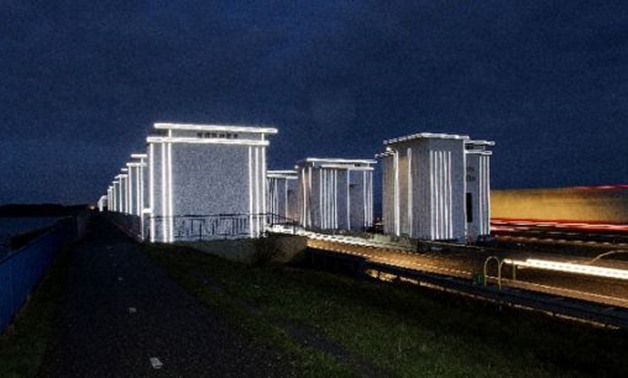
A project by Dutch artist Daan Roosegaarde and his team lit up the floodgates of the Afsluitdijk dyke in The Netherlands on Thursday (AFP Photo/Olaf KRAAK)
AFSLUITDIJK (Netherlands) — 17 November 2017: Dutch artists unveiled a design and light show yesterday to highlight one of the country’s landmark engineering projects, built more than 80 years ago as part of The Netherlands’ famed sea defences.
As daylight faded, the art project to celebrate the Afsluitdijk — a bridge which runs 32km across a gulf in the northern Netherlands — was lit up by the lights of passing cars driving across the famous divide.
The Icoon Afsluitdijk project is designed to shine at night “to enhance and safeguard” the dyke’s “rich heritage and anchor its position in the world as a Dutch water engineering and design icon,” its creators said.
Commissioned by the Dutch government, the project consists of a number of art installations, of which the last, called Gates of Light, was unveiled yesterday.
Artist Daan Roosegaarde and his team applied a reflective layer to the Afsluitdijk’s 60 imposing floodgates, which allows the concrete gates to brightly light up at night in the retro style of the 1930s, when the dyke was first built by hand.
There are also a number of temporary installations including one called Windvogel (Wind Bird) in which huge kites generate enough electricity to light up their specially designed anchor lights with luminous colours.
Roosegaarde said the structure, which was completed on May 28, 1932, “needed a renovation”.
“We restored the historical floodgates, renovated them, removed the rotten concrete and added a layer of reflective material,” he told AFP.
Referring to the importance of dykes, which help keep out the water in a country where 26 per cent of the land is below sea level, Roosegaarde said: “Dykes in The Netherlands are as holy as cows in India.”
The Afsluitdijk (literally, “cut-off dyke”) was built to keep out the North Sea and create an inland lake and polders, or land reclaimed from the sea.
It secures hundreds of square kilometres of inland coastline inside its boundaries, creating the vast but shallow IJsselmeer, which quickly turned into a freshwater reservoir.
Across the dyke stretches a multi-lane highway providing a shortcut between North Holland and Friesland, letting travellers shave almost 300 kilometres from their journey.
Even after 85 years it is still considered one of the world’s civil engineering wonders.

Comments
Leave a Comment